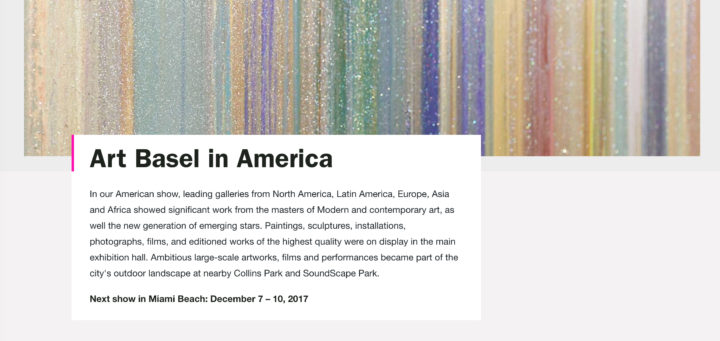By Gabriela Jurosz-Landa
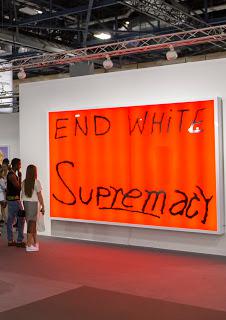
Sam Durant: End White Supremacy 2008, Blum&Poe Gallery
High hopes and big dollars were very much in evidence in a town that makes dreams come true, when the world’s most buzzing art market welcomes the art world’s international influx. From Miami to South Beach, and from the Miami Beach Convention Center to the little beach shops showing art, everyone wants to participate in the big game.
As in its past eleven years, the ART BASEL epicenter at the Miami Beach Convention Center is a display of commerce with a bit of spice. Albert Einstein’s quote should be a warning: “Strive not to be a success, but rather to be of value.” Nevertheless, too often ART BASEL is confused with an art exhibition. Even some professionals take the work shown here as an indicator for their curated museum exhibits.
The spice, this year, is called “politics.” Politics, for many years a taboo in North American arts, has recently made it into even the most pretentious salons de l’art. The current real-life North Dakota-power, though, is nowhere to be felt among the artists’ efforts, with a few exceptions.
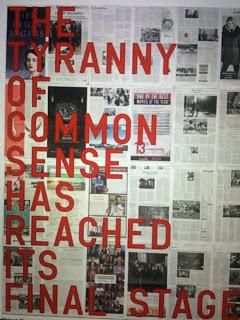
Rirkit Tiravanij. THE TYRANNY OF COMMON SENSE HAS REACHED ITS FINAL STAGE 2016 at Gavin Brown’s Enterprise
Sam Durant’s (American, 1961) black-on-orange LCD screen stating the words “End White Supremacy” (2008, Blum&Poe Gallery) greets the visitor upon entering the exhibition hall (see introductory image).
Gallery Elizabeth Dee, whose Fifth-Avenue home base currently shows an exhibit titled Every Future Has a Price, too brought a revised work to Miami – the historic photographs of Patricia Hearst. The granddaughter of American publishing magnate William Randolph Hearst, known for her confusion after being abducted, and ultimately joining a radical group, and assisting in the robbery of a San Francisco bank on April 15, 1974. The installation of the iconic black-and-white photographs attempts to connect a historic event with current politics. It also high-lights the psychology of one particular woman and associates the viewer with the current abuse of women, gays and ethnic minority groups in the president-elect’s campaign.
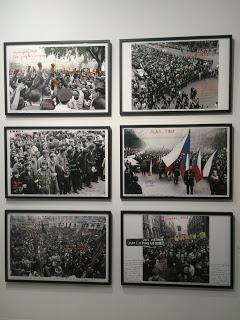
Marcello Brodsky at Henrique Faria Gallery
Henrique Faria, with galleries in New York and Buenos Aires, shows Marcello Brodsky’s (Argentinian, 1954) photo series of 1968’s world-wide marches against the Russian invasion into what was then Czechoslovakia. As in the Patty Hearst photographs, the dialog is supposed to go on in the viewer’s mind. I am not sure, however, how these six historic images might trigger a younger generation’s memory or provoke a longer-lasting thought, and so the work seems just a momentary nostalgia.
Another issue is, whether documentary photographs or pure written words are to be considered art. But in times where politics have reduced stereotypes to mere propaganda, they have become retrospectively in-the-now.
And finally, I wonder: will today’s political activists be able to empower artists and gallerists to stand up to their beliefs–even if their clients are largely from the other political coast?
Among the many celebrities attending ART BASEL was the one singer who gets away with speaking out political truth. Madonna gyrated to a slowed-down version of Britney Spears’ “Toxic” and seductively sang, “You know that you’re toxic,” as images of Trump screened behind her.
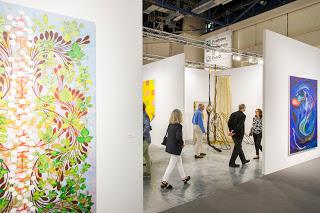
at David Zwirner Gallery
Not surprising is the dominance of art that merges nature with the digital or mechanical technical “instrumentarianism.” I define this term as “an urge to include technology into the creation of art.” This kind of art production consequentially serves instrumentalism – the belief that art must be functional (the definition could be discussed elsewhere). With some artists it seems to be part of their digital nature that they were born into and have embraced completely. Their artistic motivation speaks to an audience that too has grown up in a mostly digital world. It defines beauty newly and cannot see reality without a digital expression. Other artists attempt to fit in and want to be successful within this contemporary world-view. Their work helps to fill the void and ride the wave.
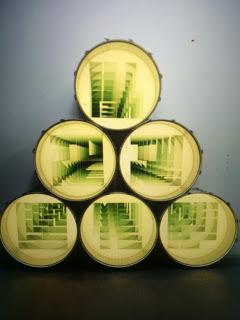
Iván Navarro. Tuning 2015
One interesting digital artist, who is at the same time one of Art Basel’s highest sold artists, is Iván Navarro (Chile 1972). His light sculptures, at Paul Kasmin Gallery, among others, hold more than other digital work. They merge technology and sculpture into a profound mythological experience, to a degree where the digital transcends space and time. His creations, made with neon, LED lights, mirrors, drums and electric energy, give a glimpse of what the universe may hold for man – past and future. There is also a sense of nature – large forests on Earth and black cosmic wholes. The relation to nature in art–concrete or abstract of any kind–is an important factor in sensing artistic quality. With his sculptural mandalas and cryptic insights into the unknown, Navarro penetrates the knowledge of artistic language like few other artists using similar media. Much of his work shows that rich historic cultural experience–individual or genetically given–does matter.
The ideal of digital beauty has a strong counter current which seems to balance out this phenomenon by digging into man’s ritualistic needs, rescuing a notion of nature or moving retro into art history, such as the “New Old Masters.”
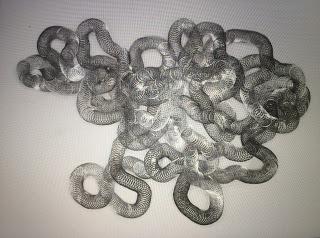
Tara Donovan. Untitled 2015. Pace Gallery
An artist bridging industrial production to nature and ritual, is Roxy Paine (American 1966). At the galleries Paul Kasmin and Kavi Gupta, he shows some of his “Art Making Machines,” mad-scientist mini-factories that produce works of art; “Replicants,” replicas of flora and fungi made out of industrial materials; “Fungal Fields,” painterly compositions of his fungi sculptures; “Specimen Cases,” vitrines filled with his fungal and floral replicas; and “Dendroids,” stainless-steel forms resembling trees and the nervous system (Artsy.net).” His reaching out into such imaginary worlds has been coming from American artists, perhaps because of lesser awareness of historical context that could hold back some European or Latin American artists in their certain cultural mind frame. Without this homogenous mind set, artists like Roxy Paine or Tara Donovan (American, 1969), dip into a depth from where they bring back these often horrific hybrids of environment and science to the surface.
The art market also presented lots of Op-Art (Julio Le Parc, Argentinian, 1928), many varieties of geometrical work (Joel Shapiro, American, 1941), as well as Asian-American Pop-culture’s baby-faces (Yoshitomo Nara, Japanese, 1959).
– – – – – – – – – – – – – – – – – – – – – – – – – – – – – – – – – – – – – – – – – – – – – – – – – – – – – – – – – – – – – –
Gabriela Jurosz-Landa is a scholar of art anthropology and anthropology. She lectures and publishes on topics of art and museology, Mayan traditions and spirituality, Czech cultural philosophy, and city-anthropology. She is a member of the Czech Association of Art Historians in Prague, and the jury of Berlin-based literary contest Federleicht. As founder and president of Forum of World Cultures, she organizes international cultural-political events. She has contributed to ANTHROPOS-Journal, the BBC, ART NEWS, DIE WELT Germany, MUENCHENER MERKUR, ATELIER Prague, Euro-Journal, PRAGER WOCHENBLATT, EL NUEVO DIARIO Nicaragua, THE REVUE Guatemala, SFERA and MLADY SVET Prague. Ms. Jurosz-Landa’s essay Emmigrantenkinder received an award from the inter-cultural magazine Český Dialog.


